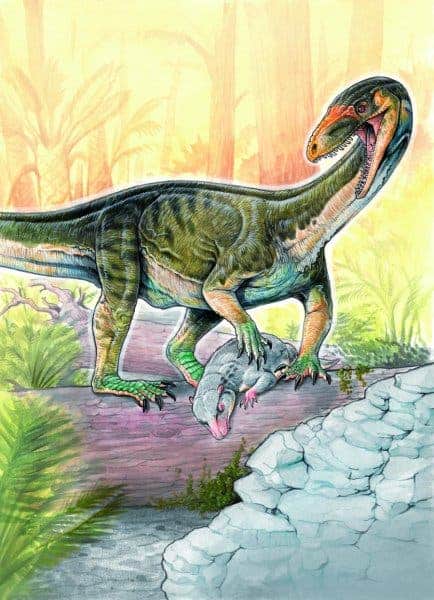We know a lot about dinosaurs but not nearly as much as about their early relatives. For years, scientists have speculated what these creatures might have looked and behaved like, based on thin and incomplete fossil records. Most assumed these would have looked like miniature dinosaurs, no bigger than a chicken, and walked on two legs. Paleontologists from Virginia Tech have toppled this belief with the latest discovery of a 245-million-year-old dino cousin.

Artist impression of Teleocrater rhadinus hunting a cynodont, a close relative of mammals. Credit: Gabriel Lio, Museo Argentino de Ciencias Naturales.
Seven to ten feet long, with a long neck and tail, and four crocodylian-like legs, the newly described species of Teleocrater rhadinus looked nothing like scientists imaged it.
Teleocrater fossils were first discovered in Tanzania in 1933 by famed paleontologist F. Rex Parrington and studied by Alan J. Charig, who used to be the curator of Fossil Reptiles, Amphibians, and Birds at the Natural History Museum of London. Because the unearthed specimens lacked crucial skeleton parts, specifically the ankle bones, Teleocrater’s place in the evolutionary family tree was uncertain. Was this creature more related to dinosaurs or crocodiles?
This very important question was settled recently after scientists discovered the missing ankle bone and other new fragments in Southern Tanzania. Unfortunately, Charig passed away before this recent development but he would have most certainly been excited by the findings.
“The discovery of such an important new species is a once-in-a-lifetime experience,” said Sterling Nesbitt, an assistant professor of geosciences in the College of Science.
Teleocrater rhadinus is so spectacular because it sheds light on the distribution and diversity of the ancestors of crocs, birds, and dinosaurs. Pre-dating dinosaurs by some 15 million years, Teleocrater rhadinus, which means “slender complete basin” alluding to the lean build, fills a large gap in the fossil record after a large group of reptiles called archosaurs split into two lineages. One’s the bird branch, which includes dinosaurs and birds, and the other is the crocodile branch which today is represented by alligators and crocodiles. Remarkably, Teleocrater is the earliest archosaur we’ve ever encountered.
Teleocrater and other dino cousins were widespread during the Triassic and lived in what’s today Russia, India, and Brazil. Though they preceded dinosaurs by millions of years, they went extinct before dinosaurs first appeared in the fossil record.
Next, Nesbitt and colleagues are heading back to southern Tanzania this year to look for more remains and missing parts of the Teleocrater skeleton.
“It’s so exciting to solve puzzles like Teleocrater, where we can finally tease apart some of these tricky mixed assemblages of fossils and shed some light on broader anatomical and biogeographic trends in an iconic group of animals,” said Michelle Stocker, a co-author of the new study which appeared in the journal Nature.









